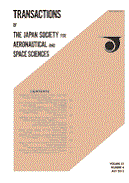
- |<
- <
- 1
- >
- >|
-
Ying XUE, Zhen Qiang YAO2020 年 63 巻 1 号 p. 1-7
発行日: 2020年
公開日: 2020/01/04
ジャーナル オープンアクセスThis paper focuses on force-fight oscillation mitigation in fly-by-wire (FBW) flight control systems (FCSs) for civil aircraft. The theory of “force fight” was first introduced after analyzing its impact on active-active actuators system. The architecture of one typical FBW FCS and the layout of an electronic hydraulic servo actuator (EHSA) were described. A force-fight mitigation algorithm applying pressure and position compensation feedback was then presented. To validate algorithm performance, an associated actuator-surface model was created to simulate force fight. Finally, the algorithm was tested using worst-case scenarios by calculating the system latency and tolerance, and verified using special ``Iron Bird'' tests. The results show an obvious decrease in the difference delta press (DDP) when comparing with/without mitigation, and thereby meeting force fight limitation requirements.
抄録全体を表示PDF形式でダウンロード (2688K) -
Hikaru AONO, Katsutoshi KONDO, Taku NONOMURA, Masayuki ANYOJI, Akira O ...2020 年 63 巻 1 号 p. 8-17
発行日: 2020年
公開日: 2020/01/04
ジャーナル オープンアクセスAerodynamics of an owl-like wing model at low Reynolds numbers (Re = O(104–5)) are investigated using large-eddy simulations with high-resolution computational schemes. The airfoil shape of the owl-like wing model is constructed based on a cross-sectional geometry of the owl wing at 40% wingspan from the root. The chord-based Re ranges from 1.0 × 104 to 5.0 × 104 and the angle of attack (α) varies from 0 to 14 deg. The time-averaged lift (Cl) and drag coefficients computed are in reasonable agreement with the results of force measurement. The results computed clarify a nonlinear change in the Cl curve slope, which is due to an increase in the suction peaks in conjunction with the change in type of separation, the formation of a laminar separation bubble (LSB), and pressure recovery on the pressure side. The generation of the LSB on the suction and/or pressure sides at the Re of 2.3 × 104 and 4.6 × 104 are seen, while reattachments are observed only on the pressure side at the Re of 1.0 × 104 due to the camber of the wing. Furthermore, the owl-like wing model demonstrates favorable aerodynamic performance in terms of a maximum lift-to-drag ratio in comparison with several airfoils at the Re range considered. This is due to the strong suction peaks and distribution of surface pressure on the pressure side. It is emphasized that the concave lower surface enhances the time-averaged aerodynamic performance at all of the α even though the LSB is generated and fluctuation in lift history is induced at low α.
抄録全体を表示PDF形式でダウンロード (3277K) -
Kotaro TAGUCHI, Koh FUKUNISHI, Shogo TAKAZAWA, Yasuto SUNADA, Taro IMA ...2020 年 63 巻 1 号 p. 18-23
発行日: 2020年
公開日: 2020/01/04
ジャーナル オープンアクセスIn order to investigate the deformation and aerodynamic characteristics of the morphing airfoil model passively deformable by the dynamic pressure, two-dimensional wind tunnel experiment was conducted. The trailing edge portion (0.3 ≤ x/c ≤ 1.0) of the model was made of flexible materials so as to be deformable by the dynamic pressure without using any actuator. The upper and lower surfaces were connected by spokes inside the airfoil. The aspect ratio of the model was 1.0 and the Reynolds number based on the chord length was 1.78 × 105 in the wind tunnel experiment. The deformed geometries were measured optically, and the lift coefficient was measured with a force sensor. The morphing airfoil deformed to increase its camber in the high angle-of-attack, and this deformation caused higher lift coefficient than that of the rigid airfoil. Also, by the measurement of Cp distribution around the rigid airfoil and the morphing airfoil, it was found that the morphing airfoil had larger difference of pressure between upper and lower surface than the rigid airfoil in the trailing edge portion.
抄録全体を表示PDF形式でダウンロード (4312K)
-
Gyujin SHIM, Jungpyo KANG, Hweeho KIM, Kwanjung YEE2020 年 63 巻 1 号 p. 24-27
発行日: 2020年
公開日: 2020/01/04
ジャーナル オープンアクセスPDF形式でダウンロード (2374K)
-
2020 年 63 巻 1 号 p. 28-29
発行日: 2020年
公開日: 2020/01/04
ジャーナル オープンアクセスPDF形式でダウンロード (71K) -
2020 年 63 巻 1 号 p. 30
発行日: 2020年
公開日: 2020/01/04
ジャーナル オープンアクセスPDF形式でダウンロード (56K)
- |<
- <
- 1
- >
- >|